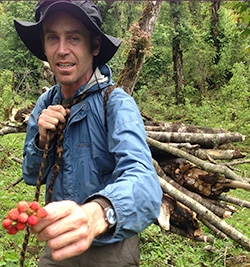By Joni B. Cole A few weeks ago, Brian Young flew back to Vermont after a three-month research trip in a remote region of Bhutan. He called his host family to let them know he arrived home safely, and just happened to catch them in the process of migrating with their herd of 60 dzomo, a yak hybrid.

“They were moving everything, household and cattle,” says Young, a student in Dartmouth’s Master of Arts in Liberal Studies (MALS) program. “I could hear the dzomo in the background. I could picture where they were in the jungle, and couldn’t believe I was able to talk to them.”
That call across continents speaks to the central question of Young’s research in this kingdom tucked away in the Eastern Himalayas. How has development—from cell phones to commercial forestry; from pastureland practices to the arrival of plastic—affected the region’s traditional culture and family life? Young’s study in Bhutan was funded in part through a graduate alumni research award and a MALS thesis award.
“For a variety of reasons, Bhutan has not received much scholarly attention, and has been quite romanticized in popular media,” says Young’s thesis adviser, Chris Sneddon, associate professor in geography and environmental studies. “Brian’s research promises to shed light on how processes of modernization and development intersect with the aspirations and practices of ordinary Bhutanese, underscoring the frictions that can arise when this occurs.”
Young spent the first days of his trip in the capital, Thimphu, interviewing government officials about Bhutan’s guide for ethical development, Gyelyong Gaki Pelzom, also known as Gross National Happiness (GNH). Created by the Center of Bhutan Studies and Oxford University, GNH surveys the population’s health and well being via economic development, environmental conservation, good governance, cultural preservation, and other measures.
“I wanted to see how GNH was actually put into practice, how development impacted the quality of daily life, including relationships across three generations of family,” Young says.
After a brief stay in the capital, he traveled east to Sherubtse College, the institution that sponsored his visa for this, his second trip to Bhutan. The college also facilitated his stay with a family from Merak, home to the semi-nomadic people known as Brokpas, or highlanders. Traditionally, the Brokpas make a living as yak herders and live in difficult-to-reach areas. Their dialect is distinct, as is their dress, most notably a black yak hair hat to cushion their heads when they are carrying heavy loads; the hat is fringed with woven yak hair to gutter away rainwater.
Young was able to live with the family in the jungle of Chaling, their winter pastureland. The family who opened their hut to Young included two parents, their college-bound eldest daughter, 20, who served as Young’s translator, a son and his wife, and a married sister who lived in a nearby hut, but helped with the family herding. Neither of the younger siblings had ever attended school, and spoke only the language unique to Merak.
Other than staying in a tent outside the family’s 11-foot-by-11-foot hut, Young participated in the family’s lifestyle as much as possible. Each morning at 4 a.m. the Laguna Beach, Calif., native trekked through the jungle to gather the scattered cattle for the first of two daily milkings. He subsisted on toh (rice) and pah (curry). Alongside his hosts, he wove and sewed, traversed the steep jungle paths to fetch drinking water, and churned yak milk into butter and cheese.
Yet while the family continues its traditional practices, Young noted that they also have adopted lifestyle changes both subtle and significant. They now transport their drinking water in a plastic container rather than one made of bamboo. Their butter churn is mechanized, greatly easing the effort. From the treetops, the father can call his kids on his cell phone, and is better able to reach buyers for his milk products in both the village and in India.
Young witnessed further signs of a traditional culture in compromise. The college-bound daughter talked of missing her friends on Facebook. The son used hair gel and sported the latest Korean fashions. His wife confided that they want to live in the village, to give up herding and open a store.
The family shared with Young their mixed feelings about these signs of development. On one hand, they see the opportunities afforded the eldest daughter, thanks to her education and ability to speak English and Dzongkha, the national language of Bhutan. The expectation is that she will make a comfortable living as a teacher and raise her brother’s and sister’s children to provide similar opportunities. The family also appreciates the convenience of roads and cell phones, both of which translate to business opportunities and more time with family.
But development poses a serious threat to these semi-nomadic people who depend on cattle for their livelihood. The growth of the forestry industry has resulted in reduced pasturelands, for example.
Like his host family, Young also has mixed feelings about the changes under way in Bhutan. He understands the appeal of modernity; the tantalizing tug of technology. (As part of his research, Young mounted a GoPro camera on a dzomo to follow its grazing patterns.) But Young, who has been invited to present his research at a Bhutan conference sponsored by the United Nations Population Fund, also worries about long-term consequences: livelihoods and languages lost, lands corrupted. And at the core of the issue is the possible erosion of well being, particularly from a Buddhist perspective.
“I see a lot of disadvantages of development,” Young states. “I see how it can interrupt and distract from your happiness.”

